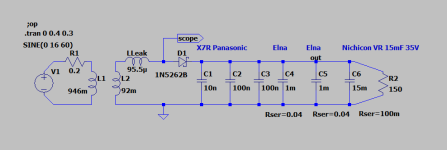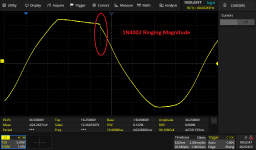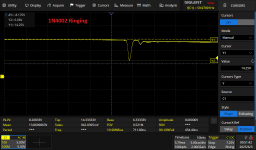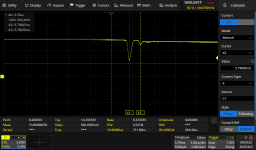First, let me commend to your reading Mark Johnson's excellent article in Linear Audio "Soft Recovery Diodes Lower Transformer Ringing by 10-20X".
I did a replication of Mark's Test fixture, some of the values are a bit different. (Was a bit puzzled that Figure 3 in the article specified a 1N5262 Zener diode, but I had one and tried it out.)
I used an old transformer, probably 1960's vintage, which I was guessing would have high leakage inductance, sure enough it measured 95uH compared to 41uH for an Antek toroid.
I was expecting the ringing of this transformer's leakage inductance and a 1N4002 diode to be in the 10's of kHz, instead almost 400kHz.
I did a replication of Mark's Test fixture, some of the values are a bit different. (Was a bit puzzled that Figure 3 in the article specified a 1N5262 Zener diode, but I had one and tried it out.)
I used an old transformer, probably 1960's vintage, which I was guessing would have high leakage inductance, sure enough it measured 95uH compared to 41uH for an Antek toroid.
I was expecting the ringing of this transformer's leakage inductance and a 1N4002 diode to be in the 10's of kHz, instead almost 400kHz.
Attachments
That's what it's measuring on the Genrad with the primaries shorted. I'll haul the bugger out to Cleveland where my VNA is resident. I only have the Genrad here.
Drift diodes with step recovery are prone for snappy behavior. For which 1N400X is a perfect example.
P.S. Ringing due to commutation in rectifier is a peculiar signature of ZVS FB converters' generation.
Small saturable inductors (sometimes even heatsunk) as well as "heavy" RC snubbers
(10s of Watts in losses are not unheard of) are usually employed to mitigate the issue.
In mains frequency rectifier it's more of annoyance being an additional noise source.
Perhaps "ideal rectifier" IC/FET combo like LT4322 TEA220X IR11688 will do better?
P.S. Ringing due to commutation in rectifier is a peculiar signature of ZVS FB converters' generation.
Small saturable inductors (sometimes even heatsunk) as well as "heavy" RC snubbers
(10s of Watts in losses are not unheard of) are usually employed to mitigate the issue.
In mains frequency rectifier it's more of annoyance being an additional noise source.
Perhaps "ideal rectifier" IC/FET combo like LT4322 TEA220X IR11688 will do better?
@jackinnj: A multifrequency measurement is far more reliable and your VNA will give an incontestable answer.
@alexberg: Would you care to elaborate on the physics of drift diodes and their consequent behaviour?
I use Mark Johnson's "Quasimodo" and it's very good, enabling quick determination of snubbers. With the right snubber, even 1N4007 seems fine. Which is nice. And cheap.
@alexberg: Would you care to elaborate on the physics of drift diodes and their consequent behaviour?
I use Mark Johnson's "Quasimodo" and it's very good, enabling quick determination of snubbers. With the right snubber, even 1N4007 seems fine. Which is nice. And cheap.
I would agree on that. An ultimate snubber is usually (quasi)resonant mode of operation.With the right snubber, even 1N4007 seems fine.
In regard to drift diodes. AFAIK it only applies to older slow Si rectifiers. Do not ask me why - I'm no way semi specialist.
Please correct me if I'm wrong (too well seasoned), there's concentration gradient along the "base" of a diode due to a limited mobility. It's usually drawn like trapezoid converting into a triangle. Once the concentration becomes zero at one end, current stops rather suddenly.
I don't have the Linear Audio issue at hand right now, but when I remember it wright he used a variac between wall socket and transformer to make up for shifts in line voltage. It was a point of discussion when the article was published. Do you see a difference between a set up with and without a variac? Does it influence the ringing?I did a replication of Mark's Test fixture, some of the values are a bit different. (Was a bit puzzled that Figure 3 in the article specified a 1N5262 Zener diode, but I had one and tried it out.)
I also used a "variac" -- in an Eico 1078 which is fused and has meters to read current and voltage. Should have no bearing on the results. It was set such that the output voltage was 15 VDC and current 100mA. I believe Variac is a Genrad trade-marked auto-transformer, but haven't taken apart the Eico to see if it is GenRad.
- Home
- Amplifiers
- Power Supplies
- More snubber musings




